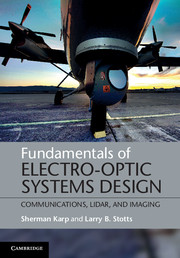Book contents
- Frontmatter
- Contents
- Preface
- Notation
- 1 Genesis of electro-optic systems
- 2 Role of electromagnetic theory in electro-optics systems
- 3 Photo-detection of electromagnetic radiation
- 4 Metrics for evaluating photo-detected radiation
- 5 Contrast, visibility and imaging
- 6 Signal modulation schemes in optical communications
- 7 Forward error correction coding
- 8 Modern communications designs for FOC/FSOC applications
- 9 Light detection and ranging
- 10 Communications in the turbulence channel
- 11 Communications in the optical scatter channel
- Appendix A Two-dimensional Poisson processes
- Appendix B Propagation of finite beams in water
- Appendix C Non-Lambertian scattering
- Appendix D Communications noise sources besides signal/background shot noise
- Index
- References
6 - Signal modulation schemes in optical communications
Published online by Cambridge University Press: 05 February 2013
- Frontmatter
- Contents
- Preface
- Notation
- 1 Genesis of electro-optic systems
- 2 Role of electromagnetic theory in electro-optics systems
- 3 Photo-detection of electromagnetic radiation
- 4 Metrics for evaluating photo-detected radiation
- 5 Contrast, visibility and imaging
- 6 Signal modulation schemes in optical communications
- 7 Forward error correction coding
- 8 Modern communications designs for FOC/FSOC applications
- 9 Light detection and ranging
- 10 Communications in the turbulence channel
- 11 Communications in the optical scatter channel
- Appendix A Two-dimensional Poisson processes
- Appendix B Propagation of finite beams in water
- Appendix C Non-Lambertian scattering
- Appendix D Communications noise sources besides signal/background shot noise
- Index
- References
Summary
Communications systems are designed to send information from one point to another in the face of corrupting noise, signal loss and other degrading effects. Because these effects are statistical in nature, the field of signal detection and estimation was created to provide an analytical means to quantify link performance, establishing the quality of the information transfer. Although communications moved from point-to-point data links to networking among many users in the last decade, link analysis is still important to setting link performance even though networking can help overcome link performance limitations.
The most commonly used parameter for link analysis is the signal-to-noise ratio (SNR), which is normally defined as the ratio of the average signal power to the average noise power at some point in the receiver chain. Although to first order, optical and radio frequency (RF) communications systems operate essentially in the same way, their detection processes are different [1–3].
In an RF receiver, the first detector senses the signal and noise field strengths. The noise input to this detector is usually caused by thermal noise from the antenna and the associated field preamplifier.
- Type
- Chapter
- Information
- Fundamentals of Electro-Optic Systems DesignCommunications, Lidar, and Imaging, pp. 99 - 120Publisher: Cambridge University PressPrint publication year: 2012



